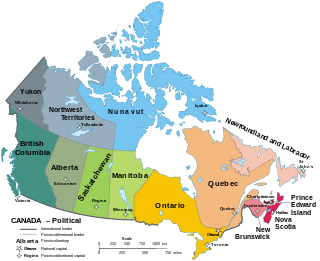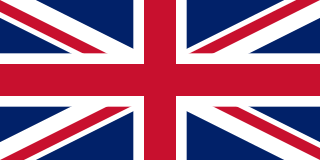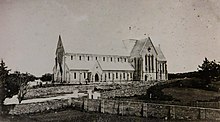
Canada has ten provinces and three territories that are sub-national administrative divisions under the jurisdiction of the Canadian Constitution. In the 1867 Canadian Confederation, three provinces of British North America—New Brunswick, Nova Scotia, and the Province of Canada —united to form a federation, becoming a fully independent country over the next century. Over its history, Canada's international borders have changed several times as it has added territories and provinces, making it the world's second-largest country by area.

British North America comprised the colonial territories of the British Empire in North America from 1783 onwards. English colonisation of North America began in the 16th century in Newfoundland, then further south at Roanoke and Jamestown, Virginia, and more substantially with the founding of the Thirteen Colonies along the Atlantic coast of North America.

The Anglican Church of Canada is the province of the Anglican Communion in Canada. The official French-language name is l'Église anglicane du Canada. In 2022, the Anglican Church counted 294,931 members on parish rolls in 1,978 congregations, organized into 1,498 parishes. The 2021 Canadian census counted 1,134,315 self-identified Anglicans, making the Anglican Church the third-largest Canadian church after the Catholic Church and the United Church of Canada.

The Cathedral of St. John the Baptist is an Anglican cathedral located in the city of St. John's, Newfoundland and Labrador, Canada. The church is considered to be the mother church for Anglicans in Newfoundland and Labrador.

The history of the Anglican Communion may be attributed mainly to the worldwide spread of British culture associated with the British Empire. Among other things the Church of England spread around the world and, gradually developing autonomy in each region of the world, became the communion as it exists today.

James Butler Knill Kelly was a bishop of the Church of England active in the British colony of Newfoundland and Scotland. Kelly was a participant in the first Lambeth Conference, which was a crucial step in the creation of the Anglican Communion. He was also Primus of the Scottish Episcopal Church from 1901 to 1904.

Aubrey George Spencer was the first bishop of the Anglican Diocese of Newfoundland and Bermuda (1839–1843). He was also bishop of Jamaica. His brother George Spencer became Bishop of Madras. He is from the Spencer family.

The Diocese of Nova Scotia and Prince Edward Island is a diocese of the Ecclesiastical Province of Canada of the Anglican Church of Canada. It encompasses the provinces of Nova Scotia and Prince Edward Island and has two cathedrals: All Saints' in Halifax and St. Peter's in Charlottetown. Its de facto see city is Halifax, and its roughly 24 400 Anglicans distributed in 239 congregations are served by approximately 153 clergy and 330 lay readers according to the last available data. According to the 2001 census, 120,315 Nova Scotians identified themselves as Anglicans, while 6525 Prince Edward Islanders did the same.
The Ecclesiastical Province of Canada, founded in 1860, forms one of four ecclesiastical provinces in the Anglican Church of Canada (ACC). Despite modern use of the name Canada, the ecclesiastical province covers only the former territory of Lower Canada, the Maritimes, and Newfoundland and Labrador. It once also included Upper Canada (Ontario), which was split off as the Ecclesiastical Province of Ontario in 1911. The province comprises seven dioceses:

Starting with the 1763 Treaty of Paris, New France, of which the colony of Canada was a part, formally became a part of the British Empire. The Royal Proclamation of 1763 enlarged the colony of Canada under the name of the Province of Quebec, which with the Constitutional Act 1791 became known as the Canadas. With the Act of Union 1840, Upper and Lower Canada were joined to become the United Province of Canada.

George Jehoshaphat Mountain was a British-Canadian Anglican bishop, the first Principal of McGill College from 1824 to 1835, and one of the founders of Bishop's University and Bishop's College School.
The Bishop of Bermuda is an episcopal title given to the ordinary of the Anglican Church of Bermuda, one of six extra-provincial Anglican churches within the Church of England overseen by the Archbishop of Canterbury. The present Bishop is Nick Dill.

The Anglican Church of Bermuda is a single diocese consisting of nine parishes and is part of the Anglican Communion, though not a part of an ecclesiastical province. The current Bishop of Bermuda, seated at the Cathedral of the Most Holy Trinity in the City of Hamilton, is Nicholas Dill, who was installed on 29 May 2013.
Robert Lowder Seaborn was a Canadian minister of the Anglican faith. He was the Anglican Bishop of Newfoundland in Canada from 1965 to 1980.

The Cathedral of the Most Holy Trinity is an Anglican cathedral located on Church Street in the City of Hamilton, in Pembroke Parish, in the British Overseas Territory of Bermuda.
Vice Admiral George Murray was a Royal Navy officer and politician. He was the third son of the Jacobite general Lord George Murray.

The Roman Catholic Archdiocese of Halifax–Yarmouth is a Latin Church archdiocese that includes part of the civil province of Nova Scotia.
Geoffrey Curtis Ralph Peddle was the bishop of the Diocese of Eastern Newfoundland and Labrador from 2014 to 2020.
St. Martin's Cathedral is a pro-cathedral of the Diocese of Central Newfoundland, a diocese of the Anglican Church of Canada, in Gander, Newfoundland and Labrador. St. Martin's was established as a parish church in 1959 and was elevated as a pro-cathedral after Gander became the episcopal see of the diocese after it, the Diocese of Western Newfoundland, and the Diocese of Eastern Newfoundland and Labrador were split from the former Diocese of Newfoundland in 1976. The current dean of the cathedral is David Hewitt. The cathedral hosts ordinations and the diocesan synods.













